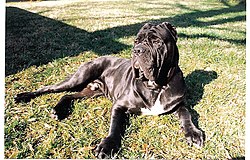
The Neapolitan Mastiff is a large, ancient breed of dog that can be traced back to about 100 BC. This massive breed is often used as a guard and defender of owner and property. The breed is reported to have been pitted against leopards in the ancient Roman arenas.
Appearance
Neapolitan Mastiffs are characterised by loose skin over their entire bodies; abundant, hanging wrinkles and folds on the head; and a voluminous dewlap. They sometimes (in rare forms) come out brown white and a tan (that in some lights may seem pink) striped. Coats can be grey (blue), black, tawny and mahogany, each colour may also come with reverse brindling . They can sometimes also have white on the chest or feet. Ears usually are half pricked and can be cropped. It has a large blocky head and a rolling gait.
Size and Proportion
According to the American Kennel Club (AKC) standards , male Neapolitan Mastiffs should measure 26-31 inches (66-79 centimeters) at the withers, weighing approximately 150 lbs (68 kilos), whilst females should be 24-29 inches (61-74 centimeters) and weigh around 110 lbs (50 kilos). Body length should be 10-15% more than that of the height. As long as proportion is maintained, larger weights are preferred, and smaller dogs may be heavily penalized, even disqualified.
Temperament
The Neapolitan Mastiffs are fearless and protective. They need to be with its family and the family's friends; as a guarding breed it is quite wary around strangers but relaxes once it gets to know the person. It does not bark excessively and indeed only barks when something provokes it. As a breed the Neapolitan Mastiff can be stubborn, but it does not require repetitive training. Once it understands what its master wants, it obeys. It has a dominant attitude and must be taught from puppyhood that its master is the boss, not the other way around. Males can be much more aggressive and dominant than females. A female works best in a home with a family, as she is a bit more docile and better with children. These dogs are, however, usually very loving with children. Males do not get along with other males, but the Neopolitan can get along well with non-canine pets if raised with them from puppyhood.
The Neapolitan Mastiff is not a breed for everyone and not a dog for beginners. Children should be taught to respect these dogs. Neapolitan Mastiffs should be well socialized at an early age to avoid over-protectiveness. They will be quite protective even with extensive socialization. Additional protection training is unnecessary because they are natural guard dogs and have been for ages. Obedience training is very important in this breed. The Mastino is generally very tolerant of pain due to the breed's early fighting background. Males often drool quite heavily. They tend to drool more in hot weather or after drinking water.
History
The Neapolitan Mastiff is a descendant of the Molossus, the mammoth war dogs of the Middle East, and was frequently used in the Roman arenas pitted against lions, bears, and gladiators for entertainment. As dogs of war, they fought alongside the Roman legions, and in this way they were spread throughout Europe. Eventually the descendants of the Roman Molossian splintered into several different Mastiff breeds known across Europe.
The ancestral form of the Mastino was a favourite breed of Alexander the Great, who was given a pair by the defeated Asian king, King Porus, in northern India in the year 326 BC.
In the 1940s, this breed was rediscovered near Naples in Italy, and is now beginning to make a comeback.
Health

The Neo is generally hardy, but like all breeds, has some specific health concerns. The most common and worrisome is hip dysplasia. Other include:
- Ectropion
- Entropion
- Cherry eye
- Elbow dysplasia
- Progressive retinal atrophy
- Hypothyroidism
- Cardiomyopathy
- Bloat
- Skin infections between skin folds
Additionally, Neos do not do well in hot weather, and are prone to heatstroke. Like most giant breeds of dogs, the Neapolitan Mastiff is not particularly long-lived, averaging 9 to 11 years.
Care and Maintenance
Due to the extensive wrinkle and large body mass Neapolitans require extra care and maintenance for bathing, cleaning the face and body. Neapolitans drool while excited, while eating, and while drinking. If the wrinkles are not cared for properly the neapolitan mastiff will smell, can form acne due to the infections. A Neapolitan's face and wrinkles should be kept as dry as possible in order to prevent such infections from forming.
Don't let the Neapolitan's size or laid back look fool you; they have bursts of energy like any other dog, especially while young, so they need to have room to run and play. When it comes to exercise, Neapolitans are not a jogging breed as their energy tends to be short lived and their weight causes stress to their joints when excessive.
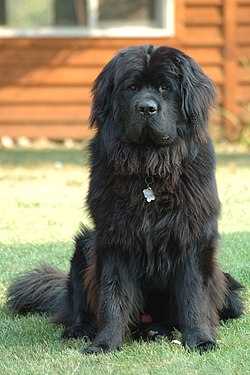
The Newfoundland is a large, usually black, breed of dog originally used as a working dog in Newfoundland. They are known for their sweet dispositions, loyalty, and natural water rescue tendencies.
Appearance
Newfoundlands ("Newfies" or "Newfs") have webbed feet and a water-resistant coat.[1] Males weigh 60–70 kg (130–150 lb), and females 45–55 kg (100–120 lb), placing them in the "giant" weight range. Some Newfies have been known to weigh over 90 kg (200 lb).
American Kennel Club (AKC) standard colors of the Newfoundland are black, brown, gray and landseer (black head and white and black body); The Kennel Club (TKC) permits only black, brown and landseer; and the Canadian Kennel Club (CKC) permits only black and landseer. The Landseer is named after the artist Sir Edwin Landseer, who featured them in many of his paintings. AKC, CKC and TKC all treat Landseer as part of the breed. FCI consider the Landseer to be a separate breed; others consider only it simply a Newfoundland color variation.
Temperament
International Kennel clubs generally describe the breed as having a sweet temperament. They have deep barks, are easy to train and are known as guardians, watchdogs and good with children.
History
The breed originated in Newfoundland from dogs indigenous to the island. There is speculation they may be descended partly from the big black bear dogs introduced by the Vikings in 1001 A.D. However it is more likely that their size results from the introduction of large mastiff type dogs, brought by generations of Portuguese fishermen. With the advent of European settlement, a variety of new breeds helped to shape and re-invigorate the breed, but the essential characteristics of the Newfoundland dog remained. By the time colonization was permitted in 1610, the distinct physical characteristics and mental attributes had been established in the breed for all time. In the early 1880s fishermen from Ireland and England traveled to the Grand Banks of Newfoundland where there were two main types of working dog: one more heavily built, large with a longish coat, whereas the other was lighter in build, an active, smooth-coated water dog. The heavier one was the Newfoundland and the other was the St. John's dog, the forerunner of the Labrador Retriever. The dogs were used in similar ways to pull fishnets and heavy equipment.
During the Discovery Channel's second day of coverage of the AKC Eukanuba National Championship on December, 03, 2006, anchor Bob Goen reported that Newfoundlands exhibit a very strong propensity to rescue people from water. Goen stated that one Newfoundland alone once aided the rescue of 63 shipwrecked sailors. Today, Kennel Clubs across the United States host Newfoundland Rescue Demonstrations, as well as offering classes in the field.
In 1832, Ann Harvey of Isle aux Morts, her father, and a Newfoundland Dog named Hairy Dog saved over 180 Irish immigrants from the wreck of the brig Despatch.
Health
There are several health problems associated with Newfoundlands. Newfoundlands are prone to Hip dysplasia (a malformed ball and socket in the hip joint), Elbow dysplasia, and cystinuria (a hereditary defect that forms calculi stones in the bladder). Another genetic problem is subvalvular aortic stenosis, also referred to as subaortic stenosis or SAS. This is a common heart defect in Newfoundlands involving defective heart valves. SAS can cause sudden death at an early age. Newfoundlands also tend to slobber copiously, but this is generally only a concern for fastidious owners, rather than for the dogs themselves.
Quotes
"The man they had got now was a jolly, light-hearted, thick-headed sort of a chap, with about as much sensitiveness in him as there might be in a Newfoundland puppy. You might look daggers at him for an hour and he would not notice it, and it would not trouble him if he did." Jerome K. Jerome Three Men in a Boat
"Near this spot are deposited the remains of one who possessed Beauty without Vanity, Strength without Insolence, Courage without Ferocity, and all the Virtues of Man, without his Vices. This Praise, which would be unmeaning Flattery if inscribed over human ashes, is but a just tribute to the Memory of Boatswain, a Dog." George Gordon, Lord Byron about his Newfoundland.
"Newfoundland dogs are good to save children from drowning, but you must have a pond of water handy and a child, or else there will be no profit in boarding a Newfoundland." Josh Billings
"A man is not a good man to me because he will feed me if I should be starving, or warm me if I should be freezing, or pull me out of a ditch if I should ever fall into one. I can find you a Newfoundland dog that will do as much." Henry David Thoreau Walden
The New Guinea Singing Dog (NGSD, New Guinea Highland Dog, or Singer) is a relative of the Australian Dingo that is native to New Guinea. Singers have remained isolated from other dogs for almost 6000 years, making them possibly the oldest of the pariah dogs. They are unique in their ability to howl in a wolf-like manner, but unlike wolves, Singers modulate the pitch, hence the name. They have a fox-like appearance, with a double coat that ranges in color from red to brown, and have a characteristically large carnassial tooth. They stand between 14 and 18 inches (36 to 46 cm) at the withers, and weigh 17 to 30 pounds (8 to 14 kg) as adults.
Once thought to inhabit the entire island of New Guinea, today wild populations are thought to be extinct, with captive specimens numbering from 100 to 200. They are exceptionally intelligent, but hard to keep because of wild behavioural traits. There is some debate as to whether Singers are truly domesticated animals, though with proper training, their pack-instincts may allow them to live with humans. They are a recognized breed by such organizations as the United Kennel Club, which classifies them as a pariah dog.
 Norfolk Terrier
Norfolk Terrier
The Norfolk Terrier is the smallest of the working Terriers. Prior to 1960, when it gained recognition as an independent breed, it was a variety of the Norwich Terrier, distinguished from the Norwich by its "drop", or folded ears.
Appearance
The Norfolk Terrier has a wire-haired coat which, according to the various national kennel club breed standards, can be "all shades of red, wheaten, black and tan, or grizzle."
They are the smallest of the working Terriers. They are active and compact, free moving, with good substance and bone. Good substance means good spring of rib and bone that matches the body such that the dog can be a very agile ratter, the function for which it was bred.
Norfolk terriers are moderately proportioned dogs. A too heavy dog would not be agile. A too refined dog would make it a toy breed. Norfolks generally have more reach and drive and a stronger rear angulation, hence cover more ground than their Norwich cousins. Norfolk have good side gait owed to their balanced angulation front and rear, not their perceived slightly longer length of back as is often cited.
The ideal height is 10 to 12 inches (25-30 cm) at the withers and weight is about 12 pounds (5 Kg).
Temperament
Norfolks are described as fearless but should not be aggressive despite being capable of defending themselves if need be. They, along with Norwich Terriers and Border Terriers, have the softest temperaments of the Terrier Group. Norfolks work in packs and must get along with other dogs. As companions in the home they love people and children and do make good pets. Their activity level is generally reflective of the pace of their environment. This breed should not be kept or live outside since they thrive on human contact. Generally Norfolks are not given to unnecessary barking or digging but, like any dog, will do either out of boredom when left alone for too long a period. They generally cohabitate well with other household pets when introduced as a puppy. Though, in the outdoors they are natural hunters with a strong prey drive for small vermin.
Norfolks are self confident and carry themselves with presence and importance, holding their heads and tails erect. A Norfolk that is shy, or carries its tail between its legs is untypical as is a dog that is hot tempered and aggressive with other dogs; these are not the standard. A Norfolk's typical breed temperament is happy, spirited and self confident. The greatest punishment to a Norfolk is his human companion ignoring him.
History
In the 1880s, British sportsmen developed a working terrier of East Anglia, England. The Norwich Terrier and later the drop-eared variety now know as the Norfolk Terrier, were believed to have been developed by crossing Cairn Terriers, small, short-legged Irish Terrier breeds and the small red terriers used by the Gypsy ratters of Norfolk.
They were first called the Cantab Terrier when they became fashionable for students to keep in their rooms at Cambridge University in England. Later, they were called the Trumpington Terrier, after a street in the area where the breed was first developed. Then, just prior to World War I, a Norwich huntsman helped introduce the short-legged terriers to the USA, calling them the Jones Terrier.
In 1932, the Norwich was granted acceptance into the English Kennel Club and the first written standard was created. The American Kennel Club registered the first Norwich Terrier in 1936. In 1964, The Kennel Club reclassified the drop-ear variety as it its own breed, the Norfolk Terrier, and the prick-eared variety retained the name Norwich Terrier. The American Kennel Club and Canadian Kennel Club both recognized the division of the Norwich Terrier breed in 1979. The Norfolk Terrier was recognized by the United Kennel Club in 1979. After many generations, these two breeds have developed as two distinct breeds both in physical looks and in temperament. Of note, there is literature that suggests that the Norfolk and Norwich were always two distinct breeds and the original mistake was classifying them as one.
Working style
Norfolks were originally bred as barn dogs to rid the barn of vermin. Some literature suggest that they were also occasionally used on the hunt to bolt animals of equal size from their den. However their short legs do not make them an endurance dog to keep up with a horse. So there is some debate as to their use on a hunt. Norfolks are pack animals and hence expected to get along with other dogs while working or in the home. As a pack dog they take turns working their prey. They are fearless and their courage is incredible. Today of course they are household companions and must have an agreeable disposition for living with people.
Health
The life expectantcy of a Norfolk Terrier is 12 to 16 years, with some growing as old as 19 years. They are generally considered as a healthy breed but there are incidences of health issues that Responsible Breeders consider worthy to do preventative testing. Norfolks have incidences of mitral valve disease, hip dysplasia, luxating patellas, and incorrect bites (where the teeth do not align with the breed standard, i.e. overshot or undershot).
Norfolks generally have small litters averaging two puppies. Responsible Breeders only breed healthy dogs that have been genetically tested for known ailments of the breed, are of good temperament, champion pedigree lineage and best reflect the written national kennel club standard. The demand for Norfolk is far greater than the supply. The environment in which they are raised directly impacts the temperament of the puppy for its lifetime. Norfolks do not thrive in kennel environments.
Grooming
These breeds have a double coat - a harsh, wiry topcoat and a soft, warm undercoat. Ideally the coat is combed daily with a steel "greyhound " comb, but all that is really necessary for grooming a companion dog is a good combing once a week to remove the loose, dead hairs and prevent matting. As a minimum, the coat should be hand stripped once in the Fall and once in the Spring. Clipping or cutting ruins the coat's colours and harsh texture. You can wash this coat with a dog shampoo any time it is desirable. For detailed information, see http://www.wildgooseterriers.com/grooming.htm
The Norbottenspets is a small, tightly-built breed of dog of the spitz type. It is an ancient breed whose original purpose was a farm and hunting dog but has recently became more popular as a companion dog.
History
The breed originated in Sweden in the 1600's. They were first used as hunting companions in northern Sweden. In 1948, norbottenspets came close to extinction but enthusiasts sought out the few remaining and started a successful breeding program. After norbottenspets narrowly escaped extinction, Finland started calling them Pohjanpystykorva. Pohjanpystykorva was then taken by immigrant farmers and given an even longer name, Norbottens-skollandehund. Unfortunately, as popularity amongst foreign` breeds increased, this breed has once again declined in popularity.
Appearance
The Norrbottenspets should be agile yet powerful in appearance. It is neither heavily nor lightly built, but somewhere in between those extremes. Males are noticiably more masculine than females, who are smaller and of lighter build. It should give the impression of being alert, sprightly, and intelligent. It is "square" in build, meaning that its height at the withers should be the same as the length of its body.
Coat and colour
The coat is hard, straight, dense, and lies close to the body. It must always have a double coat, and the under-coat is softer than the outer-coat. Colour is considered immaterial when being judged at a dog show, though white with orange, brown, or tan markings is the most common colour and is generally thought to be favourable.
Size
The height is 42 to 46cm (16.5 to 18in). The weight is approximately 11 to 15kg (24 to 33lb) for males, and 8 to 12kg (18 to 27lb) for females.

The Northern Inuit Dog is a large dog breed developed in England in the late-twentieth century.
History
In the 1980s several Inuit type dogs were imported into Britain and bred with Northern dog breeds such as the Siberian Husky and the Alaskan Malamute, the German Shepherd Dog was also included for training purposes, the resulting dogs became what we now know as the Northern Inuit dog. The aim of this selective breeding was to create a dog that closely resembles a wolf in appearance but with the gentle character of a domestic dog.
Today's Northern Inuits are no longer out crossed to any other dogs as there is a large enough gene pool to sustain the breed, they are only bred pure Inuit to Inuit, and have been for many generations.
The Northern Inuit dog is not related to any Canadian breeds and has not been bred to work as a sled dog
Contrary to popular rumour the Northern Inuit dog does not have any recent wolf heritage in its genes. Today's Northern Inuit dog retains many characteristics of their ancestors, including a willingness to please, a determination in all its undertakings and a strong hunting instinct. Their loving companionship, gentle nature and comical personality make them a perfect companion for families however large or small. However, they are not for the novice dog owner, being very independent and strong willed. Nor are they are dog that can be left alone - they need constant companionship from either another suitably sized dog able to take their boisterous play or they need to be with their owner 24/7. They become very distraught and destructive if left alone and this cannot be emphasized enough.
Anyone looking for a guard dog in the Northern Inuit dog is looking in the wrong place, a NI is a very submissive dog where both people and other dogs are concerned they would sooner greet and play with a stranger than harm them.
Over the years various people have split from the Northern Inuit Society and formed their own groups, these include the The Inuit Dog Association, the Utonagan and the Tamaskan.
Utonagan and Tamaskan should now be treated as separate breeds.
With their incredible sense of smell and willingness to please, the Northern Inuit dog could provide future services,such as search and rescue dogs, guide dogs for the blind, hearing dogs for the deaf, PAT dogs etc.
Breed standard
General appearance
A dog of medium build, athletic but not racy. Slightly longer than tall (as 10-9), with leg length slightly longer than overall depth of body. Oval bone is neither too heavy nor too light.
Head
Not too broad, skull slightly domed. Muzzle slightly longer than skull, strong and gentle tapering. Lips close fitting and always black. Cheeks flat. Nose black (winter noses acceptable) and nostrils large. Scissor bite.
Eyes
Oval, forward facing and set at a slightly oblique angle. Any colour or colour combination permitted.
Ears
Set fairly high, not too large and carried erect.
Neck
Strong and muscular with a well defined nape.
Shoulders
Moderately sloping. Elbows fitting close to chest, which must not be too broad.
Body
Topline level, ribs well back. Loin short and deep with no exaggerated tuck up. Croup broad and fairly short but not steep. Tail set fairly high and reaching to the hock, carried down when standing, may be lifted when exicted. Good rear angulation. Short hocks.
Hind feet
Oval, may have five toes, dewclaws permitted.
Fore feet
Round, pasterns upright but flexible. Pads black and well cushioned with hair.
Coat
Dense double coat, slightly harsh in texture, well defined ruff and breeches. Tail bushy.
Gait
Easy and far reaching covers the ground.
Size
Bitches 22 " minimum, dogs 24" minimum. - Overall balance more important than size.
Colour
Pure White or any shade of Grey and Sable through to pure Black. White faces and dark masks are committed but any colour change should be subtle.
Temperament
Friendly and placid, never aggressive or showing any guarding tendencies. Will submit when challenged.
Faults
Gay tails (curly), long soft silk coats, patchy/pinto or Black and Tan colours.
Any departure from the foregoing points should be considered a fault and the seriousness with which the fault should be regarded should be in exact proportion to its degree.

The Norwegian Buhund is a breed of dog, specifically a member of the spitz family. It is closely related to Icelandic Sheepdog and Jämthund. In Norwegian, hund means dog and bu refers to both homestead and livestock.
Appearance
The Buhund ranges in size from about 17 to 18 inches, and between 30 to 40 lbs. It comes in wheaten and black. The wheaten colour has a variety of shades ranging from light to almost red and with various degrees of shading from dark tipped hairs, including wolf sable, which is recognised in the UK as a separate colour.
Temperament
The Buhund is friendly and funloving and gets along with both people and other animals. They are alert, agile, and quick learners. They possess a good amount of energy, making them good for dog sports, jogging, and playing ball.
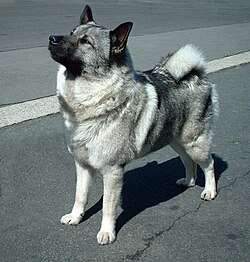
The Norwegian Elkhound is one of the ancient Northern Spitz-type breed of dog and is the National Dog of Norway. The Elkhound has served as a hunter, guardian, herder, and defender. In a land of subzero temperatures, deep snow, thick forests, and rugged mountains, only the hardiest of the breeds could evolve to perform the variety of jobs at which the Elkhound excels. Its Spitz courage is probably a by-product or residue of the fact that a significant number of them were used to hunt bear and other large game, like moose. The Norwegian Elkhound was first presented at a dog exhibition in Norway in 1877.
The AKC breed name "Norwegian Elkhound" is a direct translation from its original Norwegian name "Norsk Elghund," meaning "moose dog." (European settlers mistakenly called the North American cousin of the red deer an elk. When in fact in the German language the term elk or "elch" means moose.) Despite its name in America, it is not a hound dog: It does not hunt like a hound dog nor is it physically or physiologically related to hounds in any way. The breed's goal in the hunt is to hold the moose at bay — jumping in and out toward the moose — until the hunter can arrive to shoot it.
Appearance
The dog stands about 52 cm (20.5") high and weighs up to 24 kg (52 lbs). Its grey, white, and black coat is made up of two layers: an underlying dense smooth coat ranging from black at the muzzle, ears, and tip of its tail; to silvery grey on its legs, tail, and underbody; and an overlying black-tipped protective guard coat along its back. An ideal Elkhound has a tightly curled tail, as the dog shown in the photograph on this page. The Elkhound is a medium-sized dog and extremely hardy.
History and Evolution
The Norwegian Elkhound is a very ancient breed, having been developed over 6,000 years ago to help early Scandinavians hunt big game such as moose and bear. Remains of dogs remarkably similar to the modern Elkhound have been found in grave sites such as the Viste Cave in Jæren, Norway, where they were dated as far back as 4000–5000 BC. Archaeological digs in Scandinavia suggest this breed existed and was domesticated in the Stone age. At the end of the 19th century the breed came to England, and in 1901 the The Kennel Club officially recognised it.
For many years, the Norwegian Elkhound was considered the oldest of all dog breeds, going back further than 6,000 years. Recent DNA analysis suggests, however, that several "ancient" breeds have been "recreated in more recent times from combinations of other breeds" (Ostrander et al., 2004). The researchers found "genetic evidence for a recent origin of the Norwegian Elkhound, believed to be of ancient Scandinavian origin" . But this study only includes 85 of the world's more than 400 dog breeds, omits many primitive lineages, and clusters the breeds together into just four major groups called clades. Nevertheless, some researchers say that the Norwegian Elkhound is a descendant of the ancient "primitive" Pariah Dog that existed 4,000–7,000 years ago.
Of the four major clades that Ostrander et al. clusters together, Clade II includes dogs with the genetic haplotype D8 from two Scandinavian dog breeds: the Norwegian Elkhound and the Jämthund [note: a haplotype is a group of alleles of different genes on a single chromosome that are linked close enough together to be inherited as a single unit]. This genetic sequence haplotype is closely related to two wolf haplotypes found in Italy, France, Romania, and Greece, and is also related to a wolf haplotype found in western Russia (Vila et al., 1997). Clade II appears to be only seen in Norwegian breeds and exhibits a vast amount of divergences. It is suggested that this clade illustrates an ancient and independent origin from wolves that are now extinct (Raisor, 2004). The Norwegian Elkhound evolved, at least partially, from ancestral grey wolf subspecies now found in south central Europe and western Russia and may very well be one of the most ancient of all dog breeds.
Temperament
Norwegian Elkhounds are bred for hunting large game, such as wolf, bear and moose. The Elkhound has a very strong drive and it is not unheard of for an Elkhound to go through a plate-glass window when motivated by its quarry . Although the breed is strong and hardy, the dogs typically have an inseparable bond with their masters and are quite loyal. All Elkhounds have a sharp loud bark which makes them suitable as guard-dogs.
Norwegian Elkhounds are loyal to their "pack" and make good family dogs. It is bold, playful, independent, alert, boisterous, and protective. This is a dog ready for adventure and is happiest if that adventure takes place outdoors in cold weather. It needs daily exercise, lest it become frustrated or even destructive. It is friendly with strangers but may quarrel with strange dogs. It tends to pull when on leash unless trained, and it may bark a lot. Although each dog is an individual, they generally like children and can be very protective of those they consider part of their pack or family. This, combined with their loud bark, makes them a good watch dog.
Norwegian Elkhounds can be challenging to train because of their intelligence and deep independent streak. They are good obedience dogs and are good-natured in their disobedience — for example, failing to "come" because there is something of greater interest in the other direction. They can be wonderful in agility and are particularly good tracking dogs.
Grooming
Norwegian Elkhound's thick coats are well suited to Norwegian weather, and provide protection from the elements in two main ways. Their outer coats shed rain, snow, and sleet easily, while their under coats keep them warm in low temperatures. Because their coat is so thick, they moult twice a year, producing copious amounts of fur — in some rural regions of Norway, this fur is used to make sweaters.
Elkhounds tend to remain clean because their coat sheds most dirt and because they seem to keep themselves clean instinctively. However, elkhounds require regular brushing especially when they moult to avoid their oil glands becoming plugged and to help them stay cool in summer.
Walking
Elkhounds are truly an outside dog at heart and need to have an owner with confidence who has the ability to establish clear dominancy in the owner pet relationship. An owner who does not have the ability to establish this dominancy will find that an Elkhound may be prone to running off and ignoring any calls or commands by its owner. Elkhounds were bred to track down large game, moose specifically. It is not unheard of for the Elkhound to kill the game left unchecked. Single Elkhound been known to attack and kill moose with no outside help on their own although such occurrences are rare and are hard to prove. There is no known video evidence of these reported kills. Most are officially classified as wolf pack kills though the evidence clearly says otherwise. To get close to their prey, Elkhound will mask themselves in their targets scent. This is usually done by finding the feces of their intended prey and rolling in it until their own scent is well masked. There is an old saying found carved in the stone of excavated ancient Viking tombs which loosely translated means “Do not leave your shit lying around”. The thought was during those times if you did, it would give any potential enemy an easy kill. All that would have to be done is have his Elkhund or “hunter dog” roll in it there by creating what amounted to a fierce homing weapon with very sharp teeth. To this day be warned, if you are with your elkhound and see it rolling in another dogs feces, leash it and leave the area quickly.
Health
Norwegian Elkhounds sometimes carry a genetic predisposition to suffer from progressive retinal atrophy, or, like many medium and large breeds, hip dysplasia, renal problems and cysts, particularly in later life. Overall, however, they are a hearty breed with few health problems.
Elkhounds are very powerful animals, bred to hunt all day in cold climates, so they require plenty of exercise to feel satisfied and stay healthy. A 20–30 minute walk twice a day is recommended by many breeders.
Elkhounds are prone to rapid weight gain and must not be overfed.
They have a lifespan of 12–15 years.

The Norwegian Lundehund (Norwegian: Norsk Lundehund (from Norsk (Norwegian), lunde (puffin) and hund (dog)) is a small dog breed originating from Norway and originally bred for hunting puffins.
Appearance
The Lundehund has a great range of motion in its joints, allowing it to fit into narrow passages. The head can be bent backwards along the dog's own spine, and the forelegs can turn to the side at a 90-degree angle to its body, much like human arms. Its pricked, upright ears can be sealed nearly shut by folding them forward or backward.The Norwegian Lundehund is polydactyl: instead of the normal four toes a foot, the Lundehund has six toes, all fully formed, jointed and muscled. The outercoat is dense and rough with a soft undercoat.
History
The breed has a long history. As far back as 1600 it was used for hunting puffins along the Norwegian coast. Its flexibility and extra toes were ideal for hunting the birds in their inaccessible nesting locations on cliffs and in caves. Interest for the breed declined when new methods for hunting puffins were invented and a dog tax was created. Around 1900, they were only found in the isolated village of Mostad, Lofoten. The breed was nearly extinct around World War II when canine distemper struck Værøy and the surrounding islands; only around 6 dogs survived (1 on Værøy & 5 in southern Norway Hamar), creating a population bottleneck. Due to careful breeding with strict guidelines, there are now an estimated 1500-2000 dogs in the world, with around 1100 of the population in Norway and approximately 250 in the United States.
Lundehund Syndrome
Lundehund syndrome is a set of digestive disorders that can lead to an overgrowth of digestive bacteria, intestinal cancer, and a loss of ability to absorb nutrients from food. In extreme cases the dog can starve due to its inability to derive nutrients and protein from food, regardless of food intake. All Lundehunds have the syndrome, though not every Lundehund is severely afflicted and some are nearly symptom free. There is no cure, though the disease can be managed.

The Norwich Terrier is a breed of dog. It originates in the United Kingdom and was bred to hunt small vermin.
Appearance
These terriers are one of the smallest terriers (11-12 lb, 5-5.4 kg; 9-10 inches (24-25.5 cm) at the withers), with prick ears and a double coat, which come in red, tan, wheaten, black and tan, and grizzle.
Temperament
These small but hardy dogs are courageous, remarkably intelligent and wonderfully affectionate. They can be assertive but it is not typical for them to be aggressive, quarrelsome or shy. They are energetic and thrive on an active life. They are eager to please but have definite minds of their own. They are sensitive to scolding but 100% Terrier. They should never be kept outside or in a kennel setting because they love the companionship of their owners too much. Norwich are not given to unnecessary barking but they will warn of a stranger approaching. Norwich are good with children. If introduced to other household pets as a puppy they generally co-habit peacefully, though caution should be observed around rodent pets as they may be mistaken for prey.
History
The breed has existed since at least the late 1800s, as working terrier of East Anglia, England. The game and hardy little dogs were useful as ratters in the stable yard, bolters of fox for the hunt, and loving family companions. It was the mascot of students at Cambridge University. Small red terriers, descendants of Irish Terriers, had existed in the area since at least the 1860s, and these might be the ancestors of the Norwich, or it might have come from the Trumpington Terrier, a breed that no longer exists. In its earliest history, it was also known as the Jones Terrier and the Cantab Terrier.
Since its earliest identification as a breed, puppies have had either drop or prick ears, and both were allowed when the Norwich was first recognized in the show ring in 1932 by The Kennel Club (England). Drop ears were often cropped until it became illegal to do so. This intensified a long-standing controversy over whether drop-eared dogs should be allowed in the show ring and whether the primary difference was simply the ears or whether other, deeper, personality and structural differences marked the drop-eared variety. Starting in the 1930s, breeders increased their efforts to distinguish the breeds.
Both ear types continued to be allowed in the ring until The Kennel Club recognized the drop-eared variety as a separate breed, the Norfolk Terrier, in 1964, and the American Kennel Club, United Kennel Club, and Canadian Kennel Club did the same in 1979.
Tail docking
Outside of Canada and the United States, the docked-tail profile of the Norwich Terrier is changing. In the Australia tail docking is optional. In the United Kingdom tail docking is only permitted for working dogs and is banned for dogs bred as pets or showing. Some countries banned general tail docking for a number of years e.g. Norway since 1987, Sweden since 1988. In the last four years Cyprus, Greece, Luxembourg and Switzerland have decided to introduce a ban on tail docking. In the United States, a docked tail is currently considered necessary for success in the show ring.
Proponents of docking argue that a docked-tail dog can be extracted from a hole by the tail with less risk to the dog's spine. Opponents of tail docking note that docking severely damages the important canine tail-signalling system, so vital to dogs' social encounters, and also cite the historical basis of docking in the UK to avoid taxation of sporting dogs.
Health
The life expectancy of the Norwich Terrier is 12-16 years. While the Norwich Terrier is considered a healthy breed, there are some health issues for which responsible breeders do preventative genetic health testing, thereby reducing the incidences. For the Norwich, there are incidences of epilepsy, narrow tracheas, luxating patellas, hip dysplasia, mitral valve disease, and incorrect bites (how the teeth meet when the jaws are closed).
Norwich Terriers are tick magnets. If you live in a tick rich section of the world (New England, Northeast, upper Midwest in U.S.) it is important to use measures to prevent tick and flea infestations. It is also important to give a heartworm preventative.
Like all dogs, Norwich Terriers can have autoimmune reactivity to rabies vaccinations. Rabies-Vaccine-Induced Ischemic Dermatopathy, or RVI-ID, is a non-fatal but potentially serious reaction to chemicals called adjuvants in the vaccine. RVI-ID is often misdiagnosed, but if correctly diagnosed, is treatable. Symptoms may include: symmetrical dark spots or lesions at the tips of the ears; swelling, hard lumps or dark spots in the vicinity of the injection site.
Norwich owners are seeing more dogs with breathing concerns, and the Norwich and Norfolk Terrier Club (USA) has formed a new "Health and Genetics Sub-Committee for Research on Upper Airway Syndrome in Norwich Terriers" (source: "The Norwich & Norfolk News," Number 93, Fall 2006). Upper Airway Syndrome (UAS) covers all abnormalities that can occur in the upper airway, including: elongated soft palates; too short soft palates; narrow/misshapen tracheas; collapsing tracheas; stenotic nares (nasal passages that are too small); swollen tonsils; everted laryngeal saccules. These upper airway disorders can occur singly or in combination with one or two others. All compromise the airway and the dog's ability to breathe normally; the dog's breathing often sounds raspy or moist. It may be that shorter muzzles may have increased incidence of such issues. Reputable breeders are aware of these issues, and are working assiduously to protect the breed.
Norwich Terriers generally have small litters (1 to 3 puppies), and reputable breeders restrict the number of pregnancies their dogs have. This leads to a much smaller supply of dogs than the current demand, certainly in the US. The small supply and the high price of a pure bred Norwich Terrier - often around US$2,500 in 2006 - has attracted fraud, as unsuspecting buyers pay full price for Cairn Terriers with docked tails, or mixed-breed puppies. It is very difficult to stop this fraud. Sometimes these fake Norwich Terriers are sold over the internet. Buyers can protect themselves from fraud by working only with reputable breeders.
Exercise requirements
Norwich Terriers are hardy, active dogs, bred for a working life of pursuing vermin and accompanying their farmer owners on horseback. A good daily walk is therefore the minimum needed to meet the exercise requirements of a healthy Norwich Terrier. They are excellent walking companions. They are reasonable joggers for those who like to jog with their dogs, and with appropriate training can even accompany mountain bikes off-lead. Norwich Terriers compete in Earthdog competitions, and are increasingly common in Agility competitions. Note that these dogs were bred as working terriers, and thrive best with at least one hour of real activity daily, such as a good walk, run, or working session. Norwich are curious, independent dogs who may become bored by routine, repetitive walks/routes; they need more than access to a backyard for their physical and mental health. While these dogs are the smallest of the working terriers, they are not lapdogs and should emphatically NOT be confused with the toy breeds, which do not have the same need for activity, stimulation, and exercise.
Inadequate exercise and stimulation for your Norwich can result in behavioural problems, ranging from a tendency to over-excitement, to destructive or neurotic behaviours.
Care
Grooming
The Norwich Terrier has two coats - a harsh, wiry topcoat and a soft warm undercoat. Ideally, the coat is combed and brushed daily to once a week to remove the loose, dead hairs and prevent matting. Proper maintenance of the Norwich coat, like other hard wiry coats, requires "stripping," or pulling the oldest hairs from the coat (using fingers and/or a "stripping knife," a special grooming comb). Stripping results both in the coat retaining its proper appearance, and in the health of the dog's skin and coat. Ideally, owners hand-strip the coat on a weekly or monthly basis to achieve what is called a "rolling" coat, where hairs of all lengths are growing in. Maintaining a rolling coat is easier on the dog's skin and requires shorter grooming sessions, also easier on the dog. At minimum, the coat should be stripped once in the fall and once in the spring. Clipping or cutting negatively affects the appearance of the coat's natural colours and texture, and the impact can be permanent. Note: Elderly dogs' skin sometimes becomes more sensitive to stripping, and so elderly dogs are sometimes clipped instead of stripped. Stripping can be a positive bonding experience with your dog, if done correctly, and you can learn how to strip a Norwich from the dog's breeder (or sometimes from a knowledgeable groomer). However, this grooming requirement is not for everyone. If you don't want to learn it (or do not like to do it), consider getting a breed of dog without this grooming requirement. Otherwise, you will need to find a groomer or breeder to do it; this is a special skill that can be hard to find, and can be costly. Before purchasing a Norwich as a pet, you should see how stripping is done (and learn it) or, be certain a qualified groomer is nearby. Most local dog groomers (doing poodles, etc.) have no idea how to strip properly. They often trim the ears and maybe do some cutting too. This will damage your Norwich's coat, and result in a strange appearance.
Breeding
Norwich Terriers are difficult to breed. Many have Caesarean sections. The North American average litter size for 2005 is two puppies with the total number of puppies for the year at approximately 750.
Recently in the United States, there has been significant pedigree fraud (source: The Norwich & Norfolk News, Number 93, Fall 2006, published by the Norwich and Norfolk Terrier Club). Because the breed is so popular, and available dogs relatively scarce, unscrupulous people have been selling docked-tail Cairn Terriers or mixed-breed dogs to unsuspecting buyers. Sometimes these fake Norwich Terriers are sold over the internet. Buyers can protect themselves from fraud by working only with reputable breeders recommended by breed societies.
Appearance
According to the breed standards, the Toller should be athletic, well-muscled, compact, medium boned, balanced and powerful. The chest is deep. Conformation judges require Tollers to be capable of tolling, and physical faults that inhibit working ability are heavily penalized. They should be of moderate build—a lack of substance or a heavy build are penalized by judges, as both detract from the type and athleticism. The legs are sturdy and solid.
Those who breed Tollers for conformation shows consider the head (clean cut, slightly wedge-shaped) to be an important feature, and believe it should resemble that of a fox and must never be blocky like that of a Golden Retriever. The ears are triangular and set high and well back from the skull.
The tail is well-feathered and held jauntily when the dog is excited or moving.
Coat and color
Color is any shade of red, ranging from a golden red through dark coppery red, with lighter featherings on the underside of the tail, pantaloons, and body. Even the lighter shades of golden red are deeply pigmented and rich in color. The Toller should not be buff or brown.
The Toller has usually at least one of the following white markings - tip of tail, feet (not extending above the pasterns) chest and blaze. Lack of white is not a fault.
"The Toller was bred to retrieve from icy waters and must have a water-repellent double coat of medium length and softness, and a soft dense undercoat. The coat may have a slight wave on the back, but is otherwise straight. Some winter coats may form a long loose curl at the throat. Featherings are soft and moderate in length. The hair on the muzzle is short and fine. Seasonal shedding is to be expected." Over-coated specimens are not appropriate for a working dog.
Size and proportions
Tollers range in height from 17 to 20 inches (43-53 cm) at the withers, and weigh 37 to 51 pounds (17-23 kg); females are slightly shorter and lighter. Tollers are always a medium-sized breed, never large, however there has been a trend towards larger dogs in recent years. Tollers are traditionally the smallest breed of the retriever family.
Tollers should be slightly longer than tall (a ratio of approximately 10 to 9). However, they should not be appear long-backed either.
Temperament
"The Toller is highly intelligent, alert, outgoing, and ready for action, though not to the point of nervousness or hyperactivity. It is affectionate and loving with family members and is good with children, showing patience. Some individuals may display reserved behavior in new situations, but this is not to be confused with shyness... The Toller's strong retrieving desire coupled with his love of water, endurance and intense birdiness, is essential for its role as a tolling retriever."
Care
Tollers need a long walk every day, plus a long play session. They need to be brushed weekly.
Health
Tollers are generally hardy. However, they, like almost all dog breeds, have certain genetic disorders that are prevalent in the breed. This is sometimes blamed on a relatively small gene pool, a problem that is aggravated because some people buying Tollers only want dogs that are bred in Nova Scotia, believing that Nova Scotian dogs are the only "true" Tollers. The Toller's hereditary diseases include:
The average life span is about 11-13 years.
HistoryThe breed was developed in the Little River district of Yarmouth County, Nova Scotia around the beginning of the 20th Century to toll waterfowl.Its exact origins are not known, but it appears that some Cocker Spaniel, Golden Retriever, and/or Irish Setter may have gone into the mix. It may share origins with the smaller Kooikerhondje, which as a somewhat similar method of work.
The Toller was officially admitted to the Canadian Kennel Club in 1945. 56 years later on June 11, 2001 it was approved for admission into the Miscellaneous Class of the American Kennel Club and was granted full recognition into the Sporting Group on July 1, 2003.
The Toller was made to provincial dog of Nova Scotia in 1995.




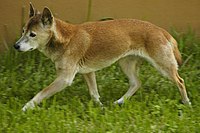


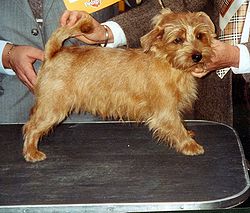
















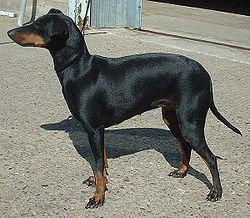

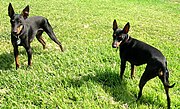









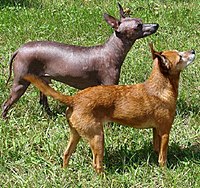









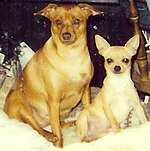

























![Validate my Atom 1.0 feed [Valid Atom 1.0]](valid-atom.png)









